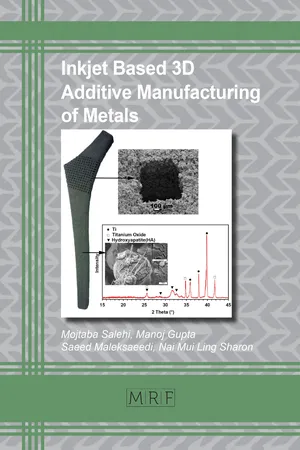
- 157 pages
- English
- PDF
- Available on iOS & Android
eBook - PDF
About this book
Particular emphasis is placed on 3D inkjet printing of metals, which is reviewed here in great depth and for the first time. This is an ambient temperature technology which offers some unique advantages for printing metals and alloys, as well as composite and functionally graded materials. Keywords: Additive Manufacturing, Inkjet Printing of Metals, 3D Printed Components, Laser Melting, Laser Sintering, Laser Powder Deposition, Material Selection Guidelines for Inkjet Printing of Metals, Biological Properties of AM Metals, Surface Properties of AM Metals, Porosity of AM Metals, Shrinkage of AM Metals, Mechanical of Properties of AM Metals, Density of Properties of AM Metals.
Frequently asked questions
Yes, you can cancel anytime from the Subscription tab in your account settings on the Perlego website. Your subscription will stay active until the end of your current billing period. Learn how to cancel your subscription.
At the moment all of our mobile-responsive ePub books are available to download via the app. Most of our PDFs are also available to download and we're working on making the final remaining ones downloadable now. Learn more here.
Perlego offers two plans: Essential and Complete
- Essential is ideal for learners and professionals who enjoy exploring a wide range of subjects. Access the Essential Library with 800,000+ trusted titles and best-sellers across business, personal growth, and the humanities. Includes unlimited reading time and Standard Read Aloud voice.
- Complete: Perfect for advanced learners and researchers needing full, unrestricted access. Unlock 1.4M+ books across hundreds of subjects, including academic and specialized titles. The Complete Plan also includes advanced features like Premium Read Aloud and Research Assistant.
We are an online textbook subscription service, where you can get access to an entire online library for less than the price of a single book per month. With over 1 million books across 1000+ topics, we’ve got you covered! Learn more here.
Look out for the read-aloud symbol on your next book to see if you can listen to it. The read-aloud tool reads text aloud for you, highlighting the text as it is being read. You can pause it, speed it up and slow it down. Learn more here.
Yes! You can use the Perlego app on both iOS or Android devices to read anytime, anywhere — even offline. Perfect for commutes or when you’re on the go.
Please note we cannot support devices running on iOS 13 and Android 7 or earlier. Learn more about using the app.
Please note we cannot support devices running on iOS 13 and Android 7 or earlier. Learn more about using the app.
Yes, you can access Inkjet Based 3D Additive Manufacturing of Metals by in PDF and/or ePUB format. We have over one million books available in our catalogue for you to explore.
Information
Table of contents
- Preface
- Acknowledgments
- Overview of Additive Manufacturing Processes for Metals
- 1.1 Introduction to Additive Manufacturing
- 1.2 Metal Additive Manufacturing
- 1.2.1 Laser Based AM Processes
- 1.2.1.1 Laser Melting
- 1.2.1.2 Laser Sintering
- 1.2.1.3 Laser Powder Deposition
- 1.2.2 Electron Beam Melting
- 1.2.3 Wire-based AM Techniques
- 1.2.4 Inkjet three-dimensional Printing (3DP)
- 1.3 Advantages and Disadvantages of the Inkjet 3DP Method
- Summary
- References
- Methods for Inkjet 3D Printing of Metals
- 2.1 Introduction
- 2.2 Binder Jetting (BJ) on Powder Bed
- 2.2.1 Liquid Binder Jetting on Powder Bed
- 2.2.2 Salt Solutions Jetting on Powder Bed [15]
- 2.2.2.1 Recrystallizing Salt
- 2.2.2.2 Reducing Salt
- 2.2.2.3 Displacing Salt
- 2.3 Solvent Jetting (SJ) on Powder Bed
- 2.3.1 Solvent Jetting on Dry Mixed Feedstock
- 2.3.2 Solvent Jetting on Coated Feedstock
- 2.3.3 Solvent Jetting on Granulated Feedstock
- Summary
- References
- Material Selection Guidelines for Inkjet 3D Printing
- 3.1 Introduction
- 3.2 Characteristics of Feedstock Materials
- 3.2.1. Powder Flowability
- 3.2.2 Powder Packing Density
- 3.2.3 Powder Sinterability
- 3.2.4 Powder Segregation
- 3.3 Ink Selection
- Summary
- References
- Inkjet Printing and Post Printing
- 4.1 Introduction
- 4.2 Fundamental of the Inkjet Technology
- 4.2.1 Methods of Drop Generation
- 4.2.1.1 Continuous Inkjet (CIJ)
- 4.2.1.2 Drop on Demand (DOD)
- 4.2.2 Interaction between Ink Drop and Powder Bed
- 4.3 Printing Parameters
- 4.3.1 Ink Saturation Level
- 4.3.2 Layer Thickness
- 4.3.3 Drying Time and Power Control
- 4.3.4 Build Orientation
- 4.3.5 Roller Spread Speed and Feed-to-Powder Ratio
- 4.4 Post-Printing Process
- 4.4.1 Post-Printing Bed Manipulation
- 4.4.2 Depowdering
- 4.4.3 Settering
- 4.4.4 Debinding and Sintering
- 4.4.5 Infiltration
- Summary
- References
- Overview of Inkjet 3D Printed Metals and Their Key Performance Indicators
- 5.1 Overview of Developed Metallic Systems
- 5.1.1 Monolithic Metals and Alloys
- 5.1.2 Composites and Functionally Graded Materials
- 5.2 Key Performance Indicators of Inkjet 3D Printed Metal Parts
- 5.2.1 Density
- 5.2.2 Shrinkage
- 5.2.3 Resolution and Surface Roughness
- 5.2.4 Porosity Related Properties
- 5.2.5 Biological Properties
- 5.2.6 Mechanical Properties
- Summary
- References
- Industry Frontiers and Applications
- 6.1 Comparison of Various Metal AM Techniques
- 6.2 Industry Frontiers
- 6.2.1 ExOne
- 6.2.2 Höganäs AB
- 6.3 Case Studies
- Summary
- References
- Index